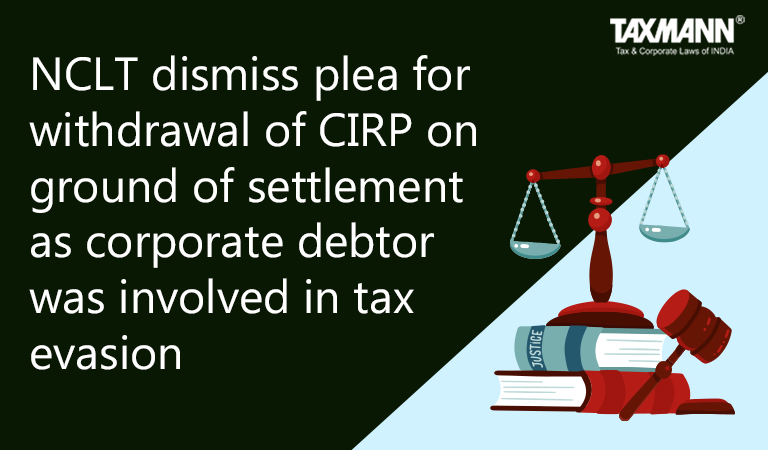NCLT dismiss plea for withdrawal of CIRP on ground of settlement as corporate debtor was involved in tax evasion
- Blog|News|Insolvency and Bankruptcy Code|
- 2 Min Read
- By Taxmann
- |
- Last Updated on 17 September, 2021

Case details: Huhtamaki PPL Ltd. v. Manpasand Beverages Ltd. - [2021] 130 taxmann.com 77 (NCLT - Ahd.)
Judiciary and Counsel Details
-
- Madan B Gosavi, Judicial Member and Virendra Kumar Gupta, Technical Member.
- Salil Thakore, Abhimany Bhandari, Swaroop George, M.K. Shah, Rashesh Sanjanwala, Ms. Ambrita, Tirth Nayak and Ruchir Patel for the Appearing Parties.
Facts of the Case
The operational creditor in this case filed an application under section 9 to initiate the Corporate Insolvency Resolution Process (CIRP) against the corporate debtor. The Adjudicating Authority granted the request and admitted an Interim Resolution Process (IRP).
However, before to the formation of the Committee of Creditors (CoC), the applicants/creditors filed an immediate motion to have the corporate insolvency resolution process of the corporate debtor halted on the grounds that the corporate debtor had paid the creditors’ dues.
NCLT Held
The NCLT of Ahmedabad Bench found that serious issues in respect of poor conduct of management are involved including the tax evasion by way of claiming wrong input tax credit thereby becoming a part of that community which has failed the intend and object of inculcating a culture of fair business practices to be adopted as a matter of policy by the business community on one hand and the other hand, it is forcing the Government to keep tax rates high. Thus, thereby hampering the economic growth of the country.
Furthermore, the IRP had brought up concerns of corporate governance, such as three audit firms resigning from their positions as internal auditors or statutory auditors in a space of 11 months. Additionally, monies were moved from the corporate debtor’s bank account to the director’s account, and payment was made to the pertinent creditor from that account.
As a result, adverse orders were issued against the director for the withdrawal of excessive pay, and stock exchanges halted trade in the corporate debtor’s shares, putting a significant number of shareholders in the dark. As a result of the foregoing, severe concerns of improper management behavior were present in the instant case.
List of Cases Referred to
-
- K.C. Sanjeev v. Easwara Pillai [Company Appeal (AT) (Insolvency) No. 1427 of 2019] (para 3)
- Swiss Ribbons (P.) Ltd. v. Union of India [2019] 101 taxamnn.com 389/152 SCL 365 (SC) (para 5)
- Brilliant Alloys (P.) Ltd. v. S. Rajagopal 2018 SCC Online SC 3154 (para 5)
- Devi Trading & Holding (P.) Ltd. v. Avani Projects & Infrastructure [CP (IB) No. 378/KB/2018] (para 5)
- DMB Geotechnics & Constructions (P.) Ltd., In re [CP (IB) No. 1798 (Mum) of 2018] (para 5)
- Jai Kishan Gupta v. Green Edge Buildtech LLP [2020] 114 taxamnn.com 109/158 SCL 116 (NCL – AT) (para 5)
- Sintex Plastics Technology Ltd. v. Zielen Industries (P.) Ltd. [Company Appeal (AT) (Insolvency) No. 1135 of 2020] (para 5)
- Phoenix Arc (P.) Ltd. v. Spade Financial Services Ltd. [2021] 124 taxamnn.com 24/165 SCL 21 (SC) (para 7)
- Madras Petrochem Ltd. v. Board for Industrial & Financial Reconstruction [2016] 66 taxamnn.com 17/134 SCL 193 (SC) (para 16)
- Arcelormittal India (P.) Ltd. v. Satish Kumar Gupta [2018] 98 taxmann.com 99/150 SCL 354 (SC) (para 16)
- Uttara Foods and Feeds (P.) Ltd. v. Mona Pharmachem [2018] 92 taxmann.com 185 (SC) (para 22)
- Neelkanth Township & Construction v. Urban Infrastructure Prestige Ltd. [2017] 85 taxmann.com 120/143 SCL 538 (NCL – AT) (para 27)
- Official Liquidator v. Dharti Dhan (P.) Ltd. AIR 1977 SC 740 (para 30).
Disclaimer: The content/information published on the website is only for general information of the user and shall not be construed as legal advice. While the Taxmann has exercised reasonable efforts to ensure the veracity of information/content published, Taxmann shall be under no liability in any manner whatsoever for incorrect information, if any.

Taxmann Publications has a dedicated in-house Research & Editorial Team. This team consists of a team of Chartered Accountants, Company Secretaries, and Lawyers. This team works under the guidance and supervision of editor-in-chief Mr Rakesh Bhargava.
The Research and Editorial Team is responsible for developing reliable and accurate content for the readers. The team follows the six-sigma approach to achieve the benchmark of zero error in its publications and research platforms. The team ensures that the following publication guidelines are thoroughly followed while developing the content:
- The statutory material is obtained only from the authorized and reliable sources
- All the latest developments in the judicial and legislative fields are covered
- Prepare the analytical write-ups on current, controversial, and important issues to help the readers to understand the concept and its implications
- Every content published by Taxmann is complete, accurate and lucid
- All evidence-based statements are supported with proper reference to Section, Circular No., Notification No. or citations
- The golden rules of grammar, style and consistency are thoroughly followed
- Font and size that’s easy to read and remain consistent across all imprint and digital publications are applied





